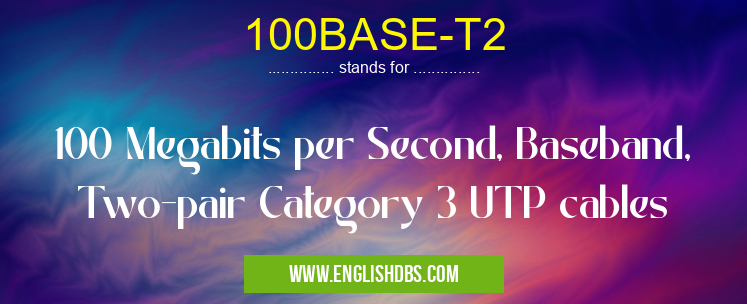What does 100BASE-T2 mean in NETWORKING
100BASE-T2 is an acronym for a type of Ethernet network that supports a data rate of 100 megabits per second (Mbps) using two pairs of twisted pair cables. It is considered to be a form of baseband communication, which means each transmitting device sends its own signal rather than sharing the same channel. The cables used are Category 3 UTP (unshielded twisted pair) cables, which use four twisted pairs for transmission instead of just two. 100BASE-T2 is considered to be a successor to the older 10BASE-T ethernet standard, and it uses the same carrier sense multiple access with collision detection, or CSMA/CD, protocol as 10BASE-T.

100BASE-T2 meaning in Networking in Computing
100BASE-T2 mostly used in an acronym Networking in Category Computing that means 100 Megabits per Second, Baseband, Two-pair Category 3 UTP cables
Shorthand: 100BASE-T2,
Full Form: 100 Megabits per Second, Baseband, Two-pair Category 3 UTP cables
For more information of "100 Megabits per Second, Baseband, Two-pair Category 3 UTP cables", see the section below.
» Computing » Networking
Essential Questions and Answers on 100 Megabits per Second, Baseband, Two-pair Category 3 UTP cables in "COMPUTING»NETWORKING"
What is 100BASE-T2?
100BASE-T2 is a network standard that supports data transfer at speeds of up to 100 megabits per second. It uses Baseband Transmission, which means the bandwidth is dedicated exclusively for transmission over two pairs of unshielded twisted pair (UTP) Category 3 cables.
What type of cables does 100BASE-T2 use?
100BASE-T2 uses two pairs of Category 3 UTP cables for transmission. UTP stands for Unshielded Twisted Pair and is a type of telecommunications cable typically used for carrying lower frequencies such as voice signals.
How much data can be transferred using 100BASE-T2?
Data transfer rates up to 100 megabits per second can be achieved with the use of 100BASE-T2. This makes it ideal for applications where higher speeds are needed but the length of the cable run is limited.
What are the advantages of using 100BASE-T2?
One benefit of using 100BASE-T2 is that it allows for higher flexibility in terms of cable length and routing. Also, since it only requires two pairs of wires it's easier to install and more cost effective than some other standards. This makes it an attractive choice for small businesses and organizations on a tighter budget.
Does 100BASE-T2 need special hardware or software?
No special hardware or software is required to use 100BASE-T2, making it relatively easy to set up and maintain. That said, you will still need compatible network interface cards (NICs) installed in each computer or device in order to communicate with each other.
What kind of environment does 100BASE-T2 work best in?
The performance benefits provided by 100BASE-T2 make it well suited for environments where shorter cable runs are necessary but high speeds are desired. This includes settings like small offices, businesses, classrooms and home networks.
Is there a speed limit when using 100BASE-T2?
Although its name implies a maximum speed limit of one hundred megabits per second, actual performance may vary depending on environmental factors like noise interference along the cable run or a slow connection at either end. As such, you should expect real world speeds closer to 90 Mbps.
How reliable is the connection with100BASETE- T2?
Thanks to features like Auto MDI/MDI cross networking technology, connections made with100 BASE - T2can often be considered quite reliable. This technology helps ensure that communication between network devices are open by automatically detecting straight through or crossover types.
Final Words:
To sum up, 100Base-T2 is an Ethernet network that uses two pairs of Category 3 UTP cable to achieve speeds of up to 100 megabits per second (Mbps). It works on the same CSMA/CD protocol as 10Base-T and allows for full duplex communication, making it an ideal choice for those looking to upgrade their networks without replacing existing cabling. It offers improved data transfer speeds compared to its predecessor while still being able to take advantage of existing cabling infrastructure.
